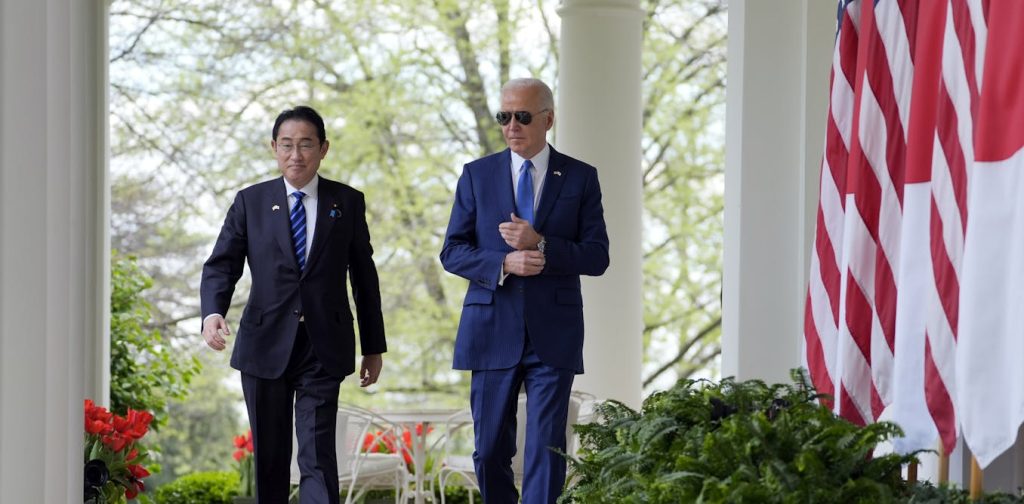Japanese Prime Minister Fumio Kishida’s state visit to the White House has already resulted in one of the most ambitious boosts to the United States-Japan alliance. This alliance is now at the core of American strategy to strengthen a regional coalition to counter China’s geopolitical rise.
in a joint press conference following a welcoming ceremony yesterday, US President Joe Biden announced a range of measures to intensify the already close defence and security co-operation between the US and Japan. This “new era” will also include the AUKUS partners and the Philippines.
Around 70 new defence co-operation agreements have now been made between Japan and the US, some of which will involve third-country partners. Prominent among these will be a networked missile defence system involving the US, Japan and Australia. This is expected to require Japan’s involvement in Pillar II of the AUKUS security alliance, particularly in development of AI and autonomous weapons.
Is Japan joining AUKUS? Not formally – its cooperation will remain limited for now
The Japanese Self-Defence Force (SDF) plans to introduce a new joint command and control centre next year. This will further deepen interoperability with the US forces in Japan.
Plans are also proceeding to service and repair US navy vessels in Japanese civilian ports. This would form part of a joint council to encourage co-production of defence systems, including missiles and jet fighter training aircraft. The council would be part of a broadening of Japanese economic investment and collaboration with the US across a range of industries and technologies.
Trilateral military training exercises with the United Kingdom are also planned. Tomorrow’s first trilateral summit between the US, Japan and the Philippines adds to the trend of overlapping minilateralism. It follows a summit held at Camp David between the US, Japan and South Korea during Kishida’s visit last year.
Camp David summit turns attention to North Korea, as well as China
Even before his current US visit, a joint naval exercise was held in the South China Sea for the first time involving warships from the US, Japan, Australia and the Philippines.
Tomorrow, a trilateral summit with Philippines President Ferdinand Marcos junior is expected to produce an agreement to maintain security and freedom of navigation in the South China Sea. This in turn will see such multilateral naval manoeuvres continue, challenging China’s territorial claims to the maritime area.
Diplomatic negotiations for a reciprocal access agreement between the Philippines and Japan will also proceed. This will allow Japanese forces to be hosted at Philippine military bases.
As Kishida began his trip, Australian Prime Minister Anthony Albanese played down the prospects of “JAUKUS”. He said Japan is likely to participate in Pillar II only on a “project by project” basis. There were no plans to have Japan formally join the AUKUS military alliance.
Kishida added at yesterday’s press conference that “nothing has been decided” regarding Japan’s direct co-operation with AUKUS. However, he reiterated that
the US foreign policy establishment has encouraged Japan to contribute to Pillar II, especially in undersea warfare, hypersonic missile development, and quantum and cyber technology.
Kishida will also make a rare joint address to Congress during this state visit. This echoes his predecessor Abe Shinzo, who used his 2015 address to Congress to promote his policy of reinterpreting Japan’s constitution to allow the SDF to engage in collective self-defence with its US ally.
Kishida’s state visit continues the diplomatic purpose of promoting bipartisan support for the US-Japan alliance. In doing so, it aims to pre-empt any diplomatic ructions that might emerge if Donald Trump were to win the November 2024 presidential election.
Japan has abandoned decades of pacifism in response to Ukraine invasion and increased Chinese pressure on Taiwan
This major diplomatic achievement by Kishida may well be among his last as prime minister. His ruling Liberal Democratic Party (LDP) has been rocked by scandals in recent years. One of those was the revelation of the Unification Church’s influence on many party members, which came to light in the wake of Abe’s assassination in 2022.
But the scandals have not stopped there. In November 2023 came revelations that senior LDP politicians had failed to report the income from fundraising parties, instead channelling it to favoured Diet members. This was in violation of Japan’s campaign financing laws.
Kishida attempted to extinguish the scandal by punishing some LDP members and completely overturning the LDP’s faction system. This led to his own faction formally dissolving, along with the largest faction formerly led by Abe. However, this has done little to endear him to the long-disillusioned voting public.
Who is Fumio Kishida, Japan’s new prime minister?
However, voters remain similarly unimpressed with the divided opposition parties. Despite some recent successes in byelections, the main opposition Constitutional Democratic Party is still unlikely to defeat the LDP-Komeito ruling coalition in the next lower house election, due to be held by October next year.
Even if the unpopular Kishida is replaced as LDP leader in an upcoming party leadership vote due in September, Japan’s potential participation in AUKUS Pillar II is likely to continue. It is now strategically placed at the fulcrum of a US-led regional coalition to deter China, as well as North Korea and Russia, in this more adversarial geopolitical environment.

